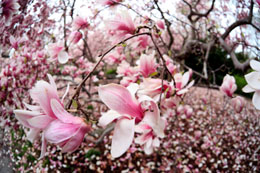The tulip tree is called so because its flowers resemble tulips. Here is a compilation of interesting facts about tulip trees for kids.

The only similarity between a tulip tree and a tulip is that the flowers look somewhat similar. But, the similarity ends here. Tulip trees are large trees belonging to the genus
Liriodendron. They have distinct leaves and flowers. Although named as tulip tree, this tree has no relation to the tulip. Flowers of this tree appear very similar to tulip or magnolia. In fact, they appear more like magnolia flowers than tulips. This is because the tulip tree belongs to the family 'Magnoliaceae'.
Facts About Tulip Trees
If you stay in the eastern part of the North America, you must be very familiar with the tulip tree or the tulip poplar. These trees are commonly found in gardens and parks. You can also plant it at home if you have a large space available. Here are some interesting facts about this beautiful tree.
- The tulip tree is a deciduous broad leaf tree, which is a native to the continent of North America.
- The tulip tree is commonly found in several parts of the United States like Michigan, Louisiana, Florida, Ohio and Indiana.
- One of the most fascinating tulip tree facts is that this tree is the state tree of three states, viz. Indiana, Kentucky and Tennessee.
- The Latin name of this tree is Liriodendron tulipifera. It is commonly known as the tulip tree, poplar, saddle leaf tree, white/yellow poplar, etc.
- The tulip tree is known as poplar because the leaves of this tree shimmer in the breeze just like those of the poplar.
- Liriodendron chinense, and Liriodendron tulipifera are the two species of this tree.
- As mentioned above, the tulip trees are large and grow to a great height. On an average, these trees grow up to 80-100 feet tall. The tallest tulip tree found on the Earth is about 200 feet tall.
- The tulip tree is one of the tallest trees found in the eastern United States.
- One of the characteristic features of this tree that helps in easy identification is that the tulip tree has a very straight bark. The bottom branches start from nearly 70-80 feet from the ground.
- The leaves of the tulip tree have four points and appear like duck's feet. The leaves of Liriodendron chinense are larger than those of Liriodendron tulipifera.
- Early summer or May is the flowering season for this tree. Usually the flowers are green in color. But in case of yellow and pink tulip trees, yellow and pink flowers respectively, are observed.
- The flowers appear at the top of the tree and hence, are very high above from the ground. Therefore, you will either need binoculars or you have to observe the fallen flowers of the tulip poplar tree.
- The flowers blossom in between spring and early summer. On the other hand, during fall, the leaves of this tree turn bright yellow.
- African tulip tree is very much different from other tulip trees. The African tulip tree belongs to the genus Spathodea, and is commonly known as Palash or flame of forest.
- The flowers of the African tulip tree are bright red or yellow; and are not similar to actual tulips in any way.
- Now, if you wish to plant these trees, note that they thrive in temperate as well as moist climates, in well-drained soil. When planted, the tulip tree grows very fast (2-3 feet every year), but does not blossom for a long time.
- Lastly, another interesting fact is that the average life span of the tulip poplar tree is 200-250 years. However, it can also live as long as 300 years.
I hope you enjoyed reading these facts. So, if you are planning to grow this tree in your garden, you can check on the Internet for more tips on tulip tree cultivation. Ciao!






 The only similarity between a tulip tree and a tulip is that the flowers look somewhat similar. But, the similarity ends here. Tulip trees are large trees belonging to the genus Liriodendron. They have distinct leaves and flowers. Although named as tulip tree, this tree has no relation to the tulip. Flowers of this tree appear very similar to tulip or magnolia. In fact, they appear more like magnolia flowers than tulips. This is because the tulip tree belongs to the family 'Magnoliaceae'.
The only similarity between a tulip tree and a tulip is that the flowers look somewhat similar. But, the similarity ends here. Tulip trees are large trees belonging to the genus Liriodendron. They have distinct leaves and flowers. Although named as tulip tree, this tree has no relation to the tulip. Flowers of this tree appear very similar to tulip or magnolia. In fact, they appear more like magnolia flowers than tulips. This is because the tulip tree belongs to the family 'Magnoliaceae'.